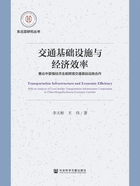
Abstract
Since the reform and opening up,China’s transportation infrastructure has developed rapidly. Large-scale transportation infrastructure investment has had a profound impact on China’s economic development. Total factor productivity is the source of long-term growth of the economy,and transportation infrastructure will affect the future economic development and government policy formulation,especially at present,the growth mode that relies on high resource input is unsustainable,the development gap between urban and rural areas is increasing. A comprehensive and accurate assessment to the impact of transport infrastructure on total factor productivity is an urgent and significant research issue. In addition,taking the Silk Road Economic Belt as an example,this paper analyzes the development of cross-border transportation infrastructure and finds that transportation infrastructure,as a channel for interconnection,can promote the economic development of countries along the line,strengthen the degree of regional economic integration,and drive the overall improvement of economic efficiency.
Based on the development of China’s transportation infrastructure at the present stage,this book studies the impact and mechanism of transportation infrastructure on economic efficiency under the new economic geography framework,and discusses the impact of transportation infrastructure to the economy by taking the area along the Silk Road Economic Belt as an example. The paper draws the following conclusions.
In the study of micro-enterprise level,the theoretical model of information technology communication is used to explain the theoretical mechanism of shortening the transportation distance affecting the total factor productivity of enterprises,and expounding several influence channels,namely,accelerating the flow of information technology. Change the structure of enterprise input and output,reduce information asymmetry,expand the market and strengthen the specialized division of labor. In the aspect of empirical test,the distance from the company to the nearest highway in the Chinese industrial enterprise database from 1998 to 2007 was measured by GIS technology,and the total factor productivity of the enterprise obtained by semi-parametric method was combined into panel data. Study the impact of transportation infrastructure on total factor productivity of enterprises,the study found that:①The increase in the distance from the enterprise to the expressway reduces the total factor productivity of the enterprise. After adding the instrumental variables and conducting the stability test,the results are still established. ②In the Heterogeneity analysis found that highways have more positive significance for non-state-owned enterprises,domestic-selling enterprises,enterprises in labor-intensive industries,enterprises in the central and western regions,and enterprises within 30-50km of expressways.
In the study of the meso-industry level,the theory of “resource mismatch” illustrates the theoretical mechanism of transportation infrastructure to reduce resource mismatch in the industry. Based on micro-enterprise data,we use the aggregate method to examine the variables at the industry level. By constructing a static regression model containing instrumental variables and a dynamic moment estimation model containing lag terms,the impact of improved transportation infrastructure conditions on industry resource mismatch is verified. The study found that:①In the case of static models and dynamic models,the improvement of transportation infrastructure conditions reduces the mismatch of industry resources. ②The heterogeneity is analyzed. From the perspective of the heterogeneity of different grades of highways,it is found that the high-grade highways have a greater effect on the improvement of resource mismatches. From the perspective of industry heterogeneity,it is found that transportation infrastructure has a greater impact on industries with low factor density. From the perspective of regional heterogeneity,transportation infrastructure has a greater impact on resource mismatch in the central and western regions.
In the study of the macro-regional level,using infrastructure externality theory model to explain the theoretical mechanism of the impact of improving transportation infrastructure conditions on macro-factor productivity,and discovering the direct and spillover effects of transport infrastructure on total factor productivity,the direct effect is to influence the growth of total factor productivity through four aspects:technology level,technical efficiency,allocation efficiency and scale efficiency. The spillover effect affects the total factor productivity of the surrounding areas through network,space-time compression effects,and knowledge gain effects. In terms of empirical analysis:①Through the analysis of the Spatial Durbin Model under three weighting conditions,it is concluded that the spatial spillover effect of transportation infrastructure on total factor productivity is positive and significant. ②Further analysis shows that the spatial spillover effect of transport infrastructure follows the law of distance attenuation,and the spillover effect shows an M-shaped trend,and the maximum regression coefficient appears at about 50 km. ③Heterogeneity analysis,first of all,the comparison of the eastern,central and western regions,the development of the three regional transportation infrastructures will have a positive and significant spillover effect. Under the condition of 0-1 weight,the eastern region has the greatest effect. Under the geographical distance weight and economic distance weight,the central region has the largest effect. Comparing the three urban agglomerations,it is found that the Pearl River Delta urban agglomeration has the largest spillover effect,followed by the Yangtze River Delta urban cluster,and the Beijing-Tianjin-Hebei urban agglomeration is the smallest.
Research on the coupling coordination degree,spatial spillover effect and boundary effect of transportation infrastructure in various cities along the Silk Road Economic Belt:①The overall coordination level of the prefecture-level cities in the China-Mongolia-Russia economic corridor is relatively high and balanced. Higher than other cities involved in economic corridors;②The spatial spillover effect of the transportation infrastructure of the New Eurasia Continental Bridge Economic Corridor is higher than that of other economic corridors;③Transportation infrastructure of New Eurasia Continental Bridge and China-Mongolia-Russia Economic Corridor have a positive impact on regional integration,and the transportation infrastructure of the Indo-China Peninsula Economic Corridor has a significant negative impact on domestic regional integration. Thereafter,taking the China-Mongolia-Russia Economic Corridor as a case,Analysis of the development of transportation infrastructure in Mongolia and Russia and the cooperation and mode of China-Mongolia cross-border infrastructure.